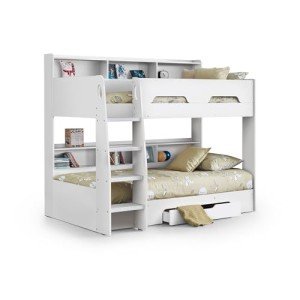With the increase of vertical living and smaller sized areas, the popularity of bunk beds has soared amongst families. Bunk beds not only provide a practical sleeping solution, especially in shared spaces, but they also bring an aspect of enjoyable into a child's life. This extensive guide explores the functions, advantages, and considerations of kids' bunk beds, making it simpler for parents to choose the best bed for their children.
Bunk beds are versatile furniture pieces that serve more than a single purpose. Here are some key functions to think about:

| Feature | Description |
|---|---|
| Product | bunk bed for adults uk beds can be constructed from wood, metal, or a combination of both, providing differing levels of durability and style choices. |
| Safety Features | Many bunk beds come equipped with guardrails, secure ladders, and capped supports for security, particularly crucial for kids. |
| Design Variety | Alternatives vary from traditional designs to modern styles, ensuring a match for any space design. |
| Space-Efficiency | Bunk beds make use of vertical space, making them ideal for smaller sized spaces. |
| Convertible Options | Some designs can be converted into 2 different beds, providing versatility as children grow. |
| Storage Solutions | Some bunk beds include integrated storage drawers or shelves, helping to keep the space arranged. |
Purchasing a bunk bed for adults uk bed comes with several advantages:
When picking the ideal bunk bed for a kid, parents must take into account various factors:
Bunk beds come in various designs and setups to match numerous requirements:
| Type | Description |
|---|---|
| Standard Bunk Bed | A classic style with one bed stacked on top of another, normally using a ladder to access the leading bunk. |
| L-Shaped Bunk Bed | Features 2 bunk beds connected in an L-shape, typically more spacious and suitable for kids sharing a room however requiring a bit more space. |
| Triple Bunk Bed | Makes up three stacked beds, ideal for maximizing sleeping arrangements in extremely minimal spaces. |
| Loft Bed | A raised bed with space underneath that can work as a play location, research study corner, or extra storage. |
| Futon Bunk Bed | Combines a bunk bed on the top with a futon or couch below, making it great for sleepovers and maximizing room use. |
| Convertible Bunk Bed | Can be separated into 2 individual beds, using flexibility as children's needs alter. |
Preserving bunk beds is crucial for ensuring durability and security. Here are some simple care practices:
Q1: At what age can a kid safely utilize a bunk bed?
A1: Generally, kids aged 6 and older are thought about safe to use the upper bunk due to the height and stability elements included.
Q2: Can I position a bunk bed near a window?
A2: It is a good idea to avoid placing a bunk bed near windows to lower the threat of falling or injuries.
Q3: Are bunk beds safe for younger children?
A3: While some modern-day bunk beds include security functions accommodating younger children, it is generally recommended to wait until they are older, usually over six years.
Q4: What is the common weight limitation for leading bunks?
A4: Weight limitations vary by model however generally range from 150 to 250 pounds. Always refer to the producer's specifications.
Q5: How frequently should I examine the bunk bed's safety features?
A5: It is recommended to perform a security check every couple of months or whenever you see any indications of wear.
Kids' bunk beds function as a strategic service for families aiming to optimize space while providing an enjoyable and engaging sleeping environment for their kids. With a variety of options offered-- from basic designs to loft beds-- parents have the liberty to select something that satisfies their family's particular requirements. By thinking about important elements such as safety, space viability, and their kids's choices, parents can make an educated option, guaranteeing that each kid is thrilled about bedtime while gaining from an efficient room.
No Data Found!

